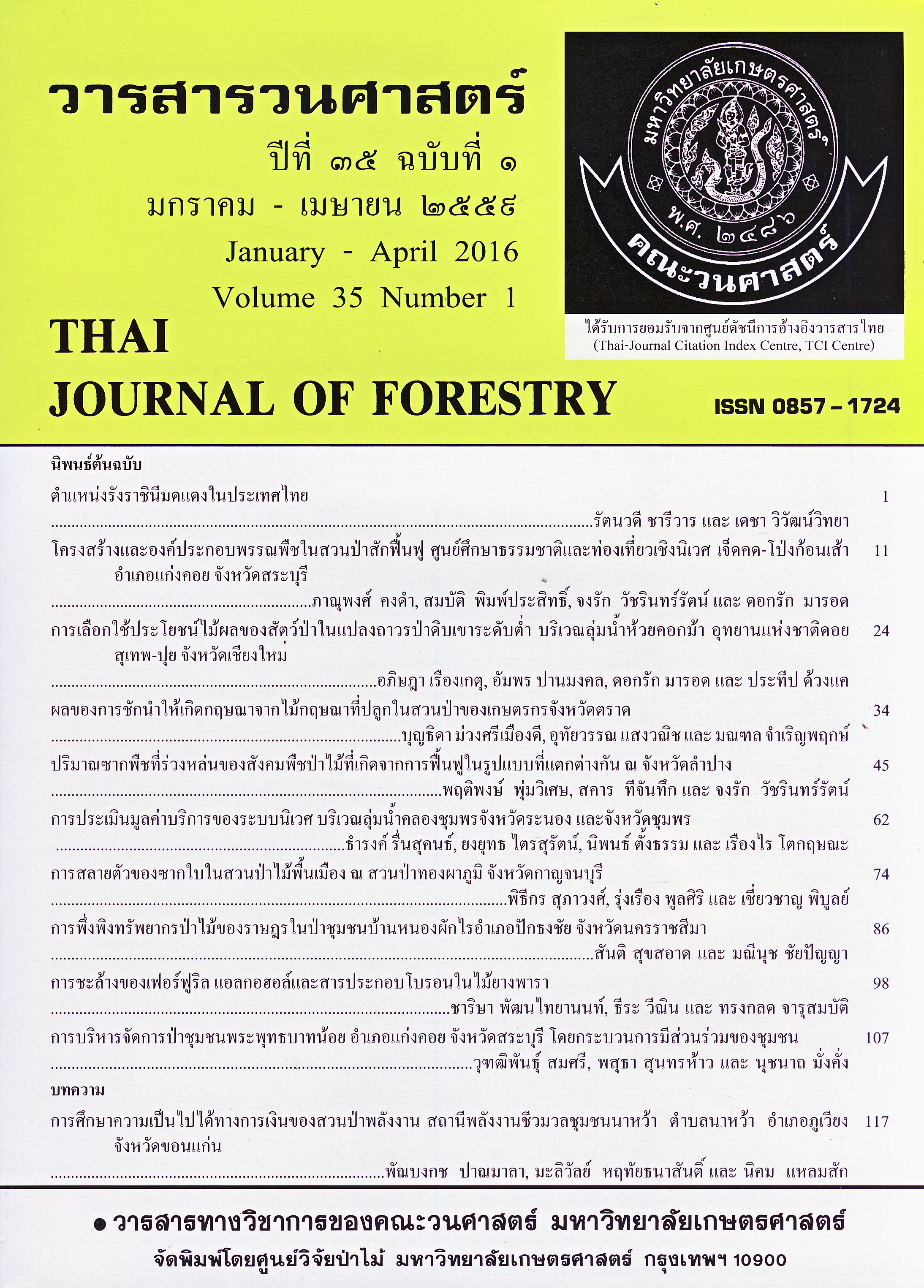การชะล้างของเฟอร์ฟูริล แอลกอฮอล์และสารประกอบโบรอนในไม้ยางพารา
Main Article Content
บทคัดย่อ
การตรวจหาอัตราการชะล้างของไม้ยางพาราที่อาบน้ำยาด้วยกรดบอริกความเข้มข้น 1% กรดบอริกผสมบอแรกความเข้มข้น 1% กรดบอริกผสมเฟอร์ฟูริล แอลกอฮอล์ความเข้มข้น 1% และกรดบอริกผสมบอแรกผสม เฟอร์ฟูริล แอลกอฮอล์ความเข้มข้น 1% การทดสอบการชะล้างปฏิบัติตามมาตรฐาน American Wood Preservation Association Standard (AWPA) E1-06 และตามมาตรฐาน British Standard Method (BS 5688: Part 1)ผลการทดลองพบว่าไม้ยางพาราอาบน้ำยาที่มีปริมาณกรดบอริกถูกชะล้างมากที่สุดในการชะล้างครั้งแรกคือ ไม้ยางพาราที่อาบน้ำยาด้วยกรดบอริกความเข้มข้น 1% มีปริมาณกรดบอริกถูกชะล้างเฉลี่ยร้อยละ 0.4361 รองลงมาคือไม้ยางพาราที่อาบน้ำยาด้วยกรดบอริกผสมบอแรกความเข้มข้น 1% กรดบอริกผสมบอแรกผสมเฟอร์ฟูริล แอลกอฮอล์ความเข้มข้น 1% และกรดบอริกผสมเฟอร์ฟูริล แอลกอฮอล์ความเข้มข้น 1% มีปริมาณกรดบอริกถูกชะล้างเฉลี่ย ร้อยละ 0.4035, 0.3590 และ 0.3354 ตามลำดับ แต่เมื่อทำการทดลองชะล้างรวม 9 ครั้ง ผลการทดลองพบว่าไม้ยางพาราที่อาบน้ำยาด้วยกรดบอริกผสมบอแรกความเข้มข้น 1% มีปริมาณกรดบอริกถูกชะล้างรวมมากที่สุดเฉลี่ยร้อยละ 1.7270 รองลงมา คือ ไม้ยางพาราที่อาบน้ำยาด้วยกรดบอริกที่ความเข้มข้น 1% กรดบอริกผสมเฟอร์ฟูริล แอลกอฮอล์ที่ความเข้มข้น 1% และกรดบอริกผสมบอแรกผสมเฟอร์ฟูริล แอลกอฮอล์ความเข้มข้น 1% มีปริมาณกรดบอริกถูกชะล้างรวมเฉลี่ยร้อยละ 1.5147, 1.3130 และ1.2567 ตามลำดับจากผลการทดลองนี้แสดงว่า เฟอร์ฟูริล แอลกอฮอล์สามารถลดการชะล้างของกรดบอริกออกจากไม้ยางพาราอาบน้ำยาได้อย่างมีประสิทธิภาพ
Downloads
Article Details
ข้าพเจ้าและผู้เขียนร่วม (ถ้ามี) ขอรับรองว่า ต้นฉบับที่เสนอมานี้ยังไม่เคยได้รับการตีพิมพ์และไม่ได้อยู่ในระหว่างกระบวนการพิจารณาตีพิมพ์ลงในวารสารหรือสิ่งตีพิมพ์อื่นใด ข้าพเจ้าและผู้เขียนร่วม (ถ้ามี) ยอมรับหลักเกณฑ์และเงื่อนไขการพิจารณาต้นฉบับ ทั้งยินยอมให้กองบรรณาธิการมีสิทธิ์พิจารณาและตรวจแก้ต้นฉบับได้ตามที่เห็นสมควร พร้อมนี้ขอมอบลิขสิทธิ์ผลงานที่ได้รับการตีพิมพ์ให้แก่วารสารวนศาสตร์ คณะวนศาสตร์ มหาวิทยาลัยเกษตรศาสตร์ กรณีมีการฟ้องร้องเรื่องการละเมิดลิขสิทธิ์เกี่ยวกับภาพ กราฟ ข้อความส่วนใดส่วนหนึ่ง หรือ ข้อคิดเห็นที่ปรากฏในผลงาน ให้เป็นความรับผิดชอบของข้าพเจ้าและผู้เขียนร่วม (ถ้ามี) แต่เพียงฝ่ายเดียว และหากข้าพเจ้าและผู้เขียนร่วม (ถ้ามี) ประสงค์ถอนบทความในระหว่างกระบวนการพิจารณาของทางวารสาร ข้าพเจ้าและผู้เขียนร่วม (ถ้ามี) ยินดีรับผิดชอบค่าใช้จ่ายทั้งหมดที่เกิดขึ้นในกระบวนการพิจารณาบทความนั้น”
เอกสารอ้างอิง
Baysal, E., S.K. Ozaki and M.K. Yalinkilic. 2004. Dimensional stabilization of wood treated with furfuryl alcohol catalysed by borate. Wood science and Technology. 38: 405-415.
British Standard Method (BS). 1979. British Standard Method. BS5688: Part 1.
Eaton, R.A. and M.D.C. Hale. 1993. Wood Decay, Pets and Protection. Chapman & Hal U.K.
Goldstein, I.S. 1960. Stable furfuryl alcohol impregnating solution. IndEng Chem. 52 (1): 57-58.
Goldstein, I.S. 1955. The impregnation of wood to impart resistance to alkali and acid. Forest Prod. J. 5 (4): 265-267.
Rubber Research Institute of Thailand Ministry of agriculture and Cooperatives. 2012. Rubberwood 2012. The Agricultural Cooperative Federation of Thailand Limited Press, Bangkok, Thailand.(in Thai)
Technical Association of the Pulp and Paper Industry (TAPPI). 2012. Technical Association of the Pulp and Paper Industry. TAPPI T610 sp-11.
Veenin T. 2006. Wood Preservative. National Science and Technology Development Agency Ministry of Science and Technology, Pathum Thani. (in Thai)
Veenin T., S. Apinuntam, P. Nimnualsri and A.Wongsiri. 1990. Natural Durability of Timbers. Technical Documentation of Forestry Conference 1990. 197-203. (in Thai)
Yun, R.J. 1991. Improvement of biologicalresistance and some physical properties of wood by resin-based treatments and its application to particle board production. PhDThesis, Kyoto University.


